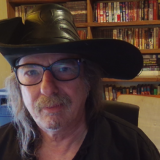This week I interviewed another who had taken a less than traditional approach to publishing, Pam Uphoff. Pam has 12 titles on Amazon that I count, and I have been reading her excellent series Wine of the Gods, which begins with Outcasts and Gods.
If you love reading strong stories, with great characters, a lovely, well-fleshed world, then you will enjoy Pam’s work. I, for one, am very happy that she got the nerve to try publishing outside the box, because it means I get to read some really good books.

Cedar Sanderson for Amazing Stories: Why do you write?
Pam Uphoff: Because I read? Because I started out mentally finishing the stories in ways I liked better? And then graduated to starting stories from scratch?
I’ve still got a stack of spiral notebooks full of (probably horrible) stories. I was thirty when we got our first computer, an Apple II+. And thirty-four before I learned how to actually use a word processor.
I was probably close to forty before I got this weird idea that perhaps I was writing well enough that other people might like to read my stories.
ASM: Why did you decide to self-publish?
PU: I had several manuscripts in circulation. I started by sending them to slush piles, and graduated to an agent. No joy, either way. I got an encouraging “Not this one, but keep it up and we want to see them” sort of note from a publisher. Sold one short story.
And sat and waited for three or four years.
And I realized that even if I did sell one, even if it did well enough that the publisher wanted to publish one or two a year, my backlog was so large I’d never get them all out in my lifetime, even if I stopped writing.
But . . . If I was my own publisher, I could put them up as quickly as I could polish them, format them, create covers for them . . .
It looked like a learning experience. And I decided to jump in the deep end.
ASM: Where did you publish? Amazon, Smashwords, B&N? What made you choose the platform(s) you did use?
PU: I started with Kindle, because it had wide exposure to the market . . . Oh, all right. I chose it because I buy so much stuff from Amazon, and it looked like it was geared for non-technical people. I’m a user, not an IT geek. I didn’t grow up speaking HTML code, so I needed instructions in old fashioned English.
ASM: How did you format your manuscript?
PU: The first thing I learned was to be as simple and basic as possible in the formatting. I used a common font. Nothing but a few italics and bolds. Title in 18 point, chapter numbers in 16, body in fourteen (hey, my eyes are just as old as the rest of me!)
Ahem. Learning experience. I figured out how to use the Header function for chapters. Bookmarks for the Table of Contents. Holy Moly! Active Tables of Contents! Stop laughing. The typewriter I learned on wasn’t even electric.
After some trial and error, it worked! And worked over and over!
Until I went to Kobo. ‘Nother learning experience.
And Print On Demand. Learning experience.
I’m starting to feel young. Mentally flexible. It’s a bit weird, but I think I like it.
ASM: How has it worked in terms of sales (I do not need specifics)?
PU: Meh. Not being a published author, I have no name recognition. And I’d rather write than sell. I’ve broken the $100 a month barrier, and stayed there, and added more books. Now I’m figuring out Kobo and POD, since I’ve got the clean manuscripts and covers handy. So I’ll be selling in more markets.
ASM:Would you doit again? Or would you prefer to publish through traditional routes?
PU: I wish I’d gotten up the nerve to jump in when Amazon first started the Kindle store. I dithered for a year and half, before I kicked myself and told myself to stop being a scaredy cat and just do it.
Mind you, my agent still has a couple of manuscripts out there. I wouldn’t mind adding traditional publishing to my spread of accomplishments.
ASM: Do you call yourself self-published, or an independent publisher? And why?
PU: I call myself a writer. Except when I’m the Senior Editor at Iron Ax Press, an Independent Publisher.
Because it’s what I am.ASM: Thank you Pam!










